NMN Supplement Enhances Effect of Fasting on Physical Performance, New Study Shows
NMN (nicotinamide mononucleotide) enhances the effect of time-restricted fasting on physical performance and muscle metabolic health in mice.
Highlights
- NMN enhances the effect of time-restricted fasting on body composition, muscle NAD+ levels, and muscle mitochondrial health.
- Time-restricted fasting improves endurance and gut microbiome health only when combined with NMN.
A recent study published in Nutrients explores a powerful new health strategy: combining time-restricted fasting (TF) with the NAD+ precursor NMN to improve energy metabolism, boost physical performance, and support healthy aging. The results suggest that this combination improves body composition, physical performance, muscle mitochondrial function, and even enhances gut microbiome health.
What Is Time-Restricted Fasting?
TF is a form of intermittent fasting where all meals are eaten within a daily window of 6–12 hours. For example, someone might eat between 10 a.m. and 6 p.m., and fast for the remaining 16 hours. Unlike calorie-restrictive diets, TF doesn’t necessarily involve eating less—just eating within a specific timeframe. Research has linked TF to several health benefits, including:
NMN Enhances the Effect of TF on Body Composition
To determine if NMN enhances the effect of TF, researchers measured the effect of TF alone and TF combined with increasingly larger doses of NMN. Mice were divided into five groups:
- Control group: normal fasting, no NMN
- TF group: time-restricted fasting, no NMN
- TFNL group: time-restricted fasting and 125 mg/kg of NMN (low dose)
- TFNM group: time-restricted fasting and 250 mg/kg of NMN (medium dose)
- TFNH group: time-restricted fasting and 500 mg/kg of NMN (high dose)
The results showed that TF increased lean mass and reduced fat mass, demonstrating an improvement in body composition. Moreover, only high-dose NMN enhanced the effect of TF on body composition, while the lower doses enhanced fat mass but not lean mass. Additionally, while TF did not increase muscle cell size, TF combined with low- or high-dose NMN increased muscle size, suggesting that TF combined with NMN could increase muscle mass.
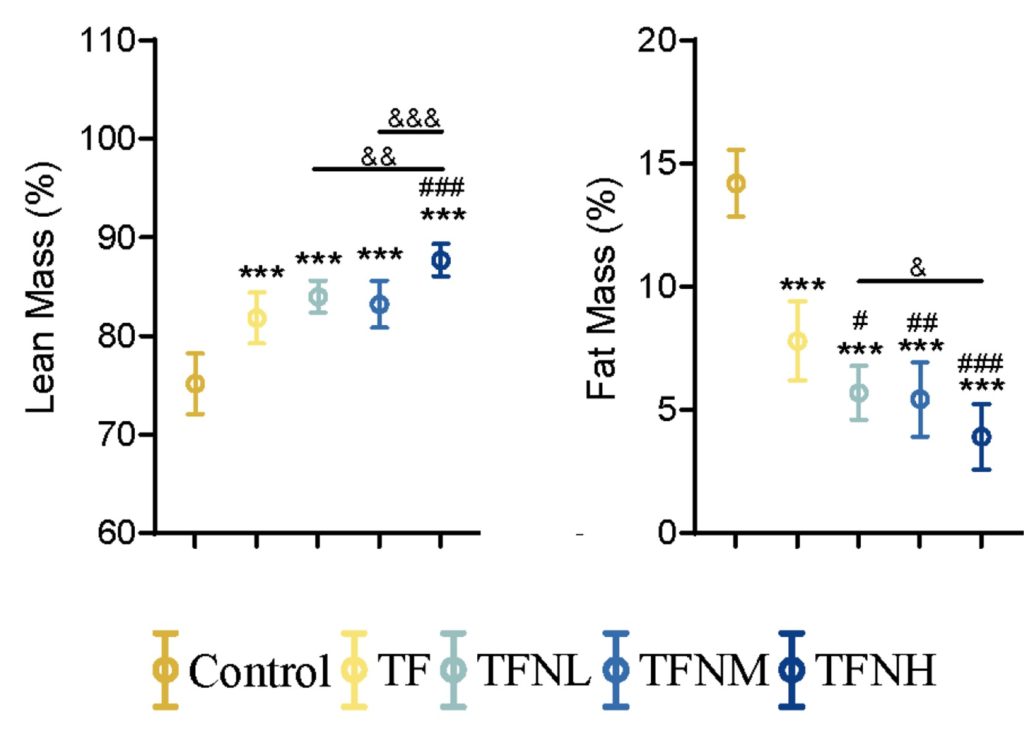
TF Improves Treadmill Endurance Only When Combined with NMN
To test endurance, the mice were subjected to treadmill exercise. Exhaustion was defined as the inability to run after five seconds of being shocked by an electric shock at the end of the treadmill. The more time spent and distance travelled on the treadmill before exhaustion was interpreted as improved endurance.
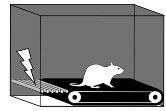
TF did not significantly increase the time it took before mice became exhausted. It also did not increase the distance run on the treadmill before exhaustion. However, all three doses of NMN combined with TF significantly increased both the time spent running before exhaustion and the distance run before exhaustion. These findings suggest that NMN may provide additional benefits not achieved through TF alone.
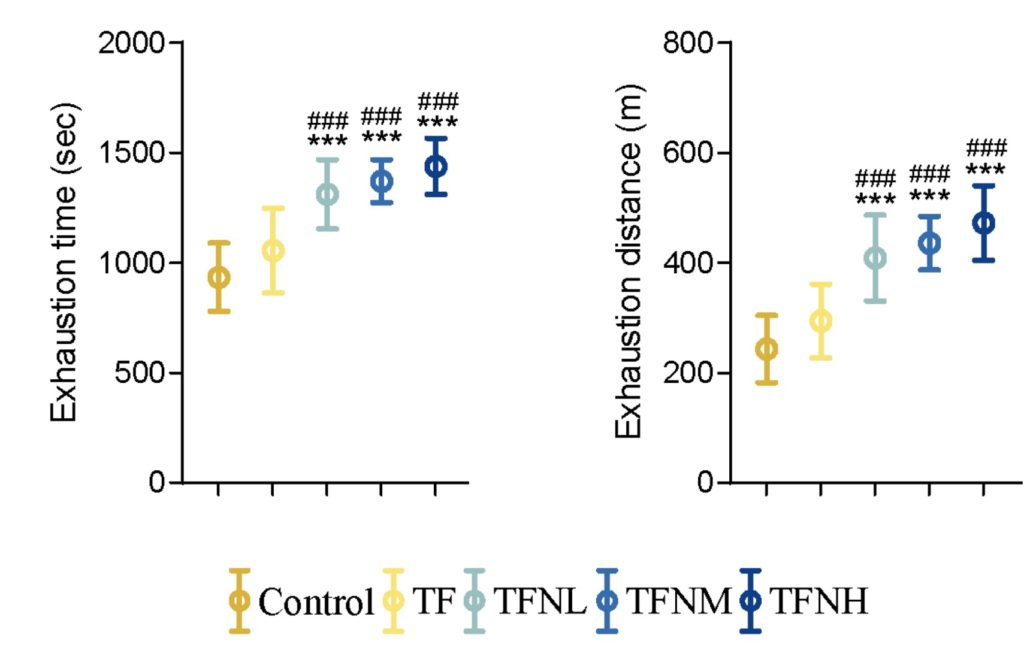
Other physical performance parameters, including time spent climbing a pole, time spent running on a rotating rod, and grip strength, were improved by TF. However, NMN enhanced only some of these parameters, and only the high dose improved grip strength. This could mean that 500 mg/kg of NMN may be the most beneficial dose for building strength in mice. Overall, combining NMN with TF had more of a beneficial effect on physical performance than TF alone.
NMN Enhances the Effect of TF on Mitochondrial Health
Aerobic activity and endurance exercise require an increase in the consumption of oxygen, which is utilized by our mitochondria to produce cellular energy — ATP. Our mitochondria make ATP through a process called respiration. However, respiration inevitably leads to the generation of reactive oxygen species (ROS), which, in excess, cause damage to cellular components like DNA. This damage is called oxidative stress, considered an underlying driver of aging, along with mitochondrial dysfunction.
One way our cells deal with oxidative stress is via antioxidants, which they naturally produce. It was found that, in general, TF reduced oxidative stress and improved cellular antioxidant activity in muscle. However, only the high dose of NMN was shown to enhance the effect of TF on mitigating muscle oxidative stress and improving antioxidant levels. Moreover, NMN (all three doses) increased muscle ATP levels, but TF did not significantly increase ATP. Furthermore, the efficiency of mitochondrial respiration, a measure of mitochondrial function, was increased only by medium- and high-dose NMN, with the high dose having the greatest effect.
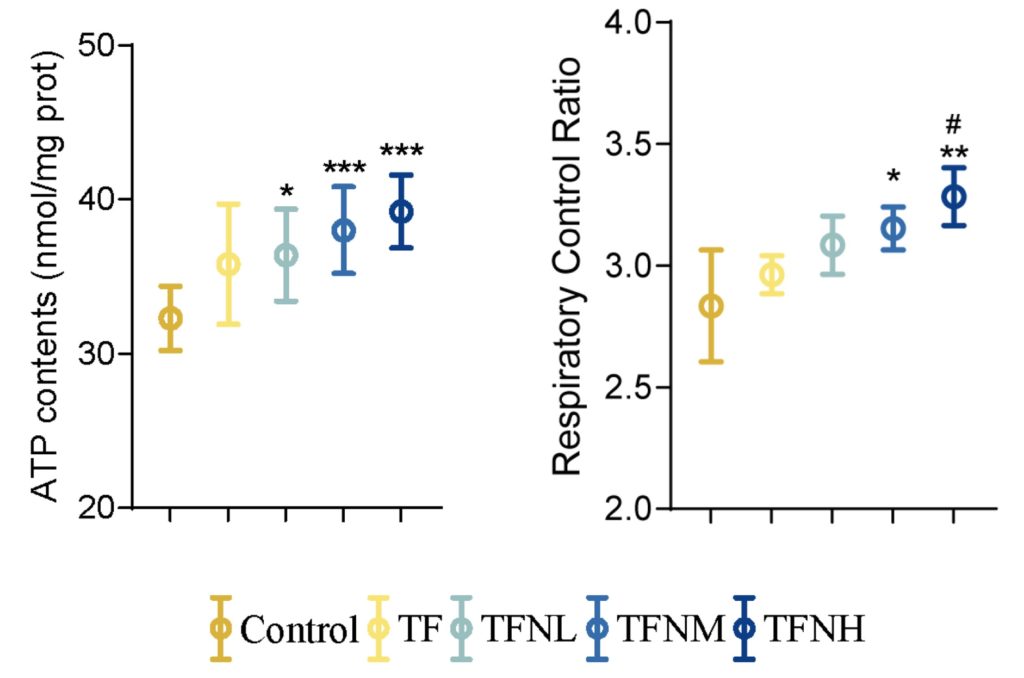
NMN Enhances the Effect of TF on Muscle NAD+ Levels
Notably, TF increased muscle NAD+, which was enhanced by all three doses of NMN. TF also increased the expression of a gene called Slc12a8 in the intestine. Slc12a8 transports NMN into cells, which in the intestines means it may increase NMN’s absorption into the bloodstream. Furthermore, NMN dose-dependently enhanced the effect of TF on Slc12a8 in the intestines. Additionally, NMN increased the expression of Slc12a8 in the hypothalamus, a brain region associated with modulating the aging process by regulating body-wide homeostasis. However, TF alone did not increase Slc12a8 in the brain. The implications of the Slc12a8 data require further investigation.
TF Improves Gut Microbiome Only When Combined with NMN
The gut microbiome — the microbes that live in our gut — is linked to age-related conditions such as inflammation, neurodegeneration, and heart disease. Both beneficial and harmful microbes, mainly bacteria, inhabit our gut and can influence the physiology of our entire body. With age, gut bacteria diversity tends to decline, encompassing a reduction in beneficial bacteria and an increase in harmful bacteria. Thus, increasing gut bacteria diversity can potentially increase the number of beneficial bacteria in the gut.
It was found that TF combined with high-dose NMN increased gut microbiome diversity while TF alone did not. The abundance of beneficial bacteria was increased, including Ruminococcus, which is linked to mediating the protective effects of exercise on the heart. TF combined with NMN and not TF alone also increased beneficial molecules secreted by gut bacteria called short-chain fatty acids (SCFAs), including acetic acid and propionic acid. In muscle, SCFAs have been shown to activate the longevity-associated enzyme AMPK and improve metabolism.
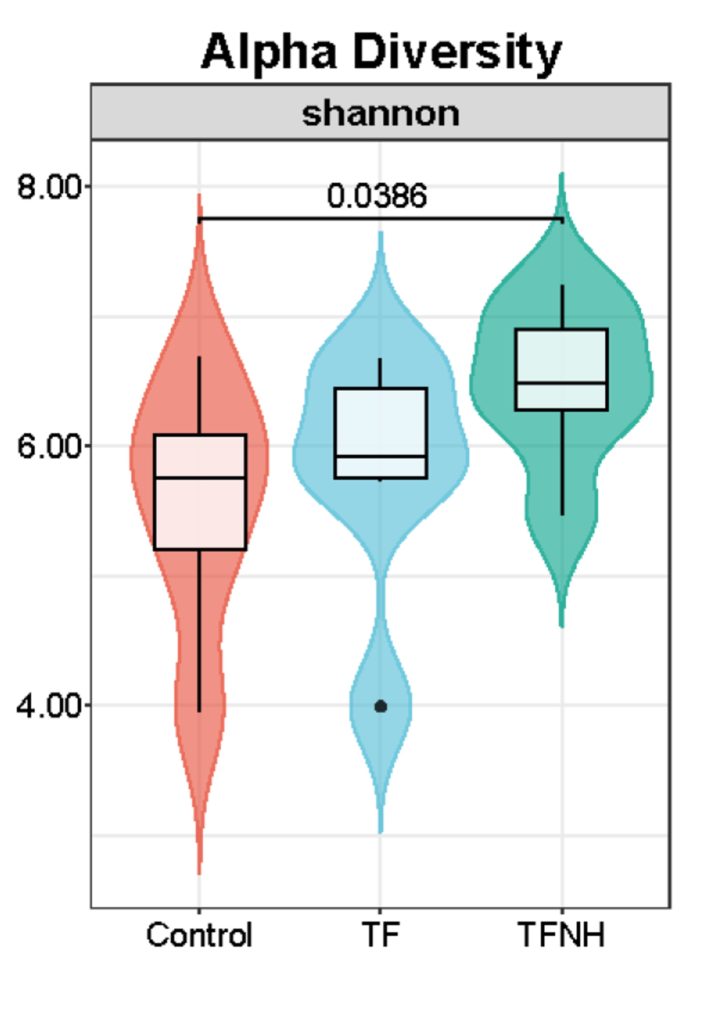
Will this Work for Humans?
While the study’s results are compelling, they were conducted in mice. Human biology is more complex, so clinical trials are needed to confirm whether the same benefits occur in people and to determine the optimal dosage and safety of NMN over the long term. Still, this study offers new insight into how simple lifestyle interventions—changing when we eat and adding a supplement—could work together to enhance energy, fitness, and health. Potential benefits for humans, particularly older and overweight individuals, may include:
- Better endurance and athletic performance
- More efficient energy use
- Reduced oxidative damage
- Support for healthy aging
- Improved gut health
Model: Male Kunming mice
Dosage: 500 mg/kg/day of NMN administered orally and time-restricted feeding for six weeks

